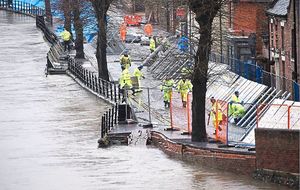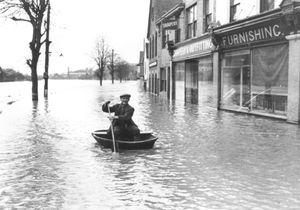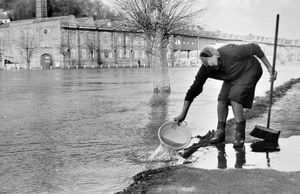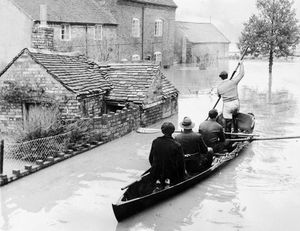£36 million to end River Severn flooding nightmare
The Government has today announced a £36 million package of measures to tackle flooding along the River Severn.

A further £4.9 million has also been earmarked to tackle flooding in Tenbury Wells.
The announcement came after Shrewsbury, Ironbridge, Bridgnorth and Bewdley suffered their worst floods in years.
In February this year the River Severn reached its highest level for 20 years, leaving much of Shrewsbury town centre under water.
Much of Ironbridge town centre had to be evacuated after flood defences were overwhelmed – with the force of the water pushing flood barriers back and leaving deep gouges in the road surface at one point. Defences were also breached in Bewdley.
The announcement comes after Daniel Kawczynski, MP for Shrewsbury and Atcham, set up an all-party group to campaign for a flood-defence programme taking in the whole of the River Severn.
Mr Kawczynski said he was delighted by the announcement, but said it was ‘just the beginning’, and that he would continue to lobby government on the matter.
The scheme is part of a wider £5.2 billion package of flood and coastal defence measures announced by Prime Minister Boris Johnson and Environment Secretary George Eustice today.

They said the schemes along the River Severn and Tenbury Wells would protect nearly 3,000 homes that were badly affected by this year’s floods.
The River Severn scheme would also create and protect more than 22,000 jobs in the area. There will also be extra funds for a scheme to underwrite insurance policies in areas that are prone to flooding.
Boris Johnson said: “Last winter I saw for myself the misery and upheaval that flooding can bring to lives and livelihoods and I said we would do more to help people
“This long-term plan will help push back the flood waters and protect hundreds of thousands of homes, businesses and livelihoods. Our record investment will also stimulate economic growth across the UK as we build back better.”
Mr Eustice said the devastating impacts of February’s floods were an important reminder of the need to speed up action to reduce the impact of flooding.
“Our record investment and ambitious policies will better protect homes, schools, hospitals and businesses, but we also recognise that we cannot prevent flooding entirely, which is why we will ensure that communities at high risk are more resilient,” he said.
“Working closely with the Environment Agency, local authorities, business and the third sector we will create a better protected and prepared nation.”
Welcomed
The leader of Shropshire Council, Peter Nutting, welcomed the grant.
He said: "Parts of Shropshire have been affected by flooding from the River Severn and its catchment tributaries for generations and we experienced another severe impact earlier this year.
"We recognise that more must be done to remove this threat and we were instrumental in forming and leading a partnership of all councils along the length of the River Severn to tackle this problem.
“Following the visits of the Secretary of State for Environment and the minister for flooding during the recent floods, we have continued to press government for recognition and support.
"The announcement of this funding is extremely welcome and is a big step towards removing the threat of flooding in Shrewsbury and other places along the length of the river.
"It will make a huge difference to the futures of towns, cities, residents and businesses that sit on the River Severn.”
Mark Barrow, Shropshire Council’s executive director of place and chairman of the River Severn Partnership, said: “The River Severn has a long history of flooding and this is a real constraint to both the resilience of towns and cities along the corridor and their growth plans, as well as to businesses which are impacted upon by flood and water resource issues.
"The River Severn Partnership can now progress the strategic modelling work to progress potential solutions which will manage and mitigate flood and water resource issues along the entire length of the Severn – including exploring energy generation opportunities.
"This is an innovative partnership of local authorities, government agencies and other stakeholders that have come together with the common aim of removing the threat of flooding and being able to view the river as an asset.”
Searching for long-term solutions to taming the destructive River Severn

Britain’s longest river has been plagued by flooding problems for decades.
There was disastrous flooding for consecutive years in 1946 and 1947, the latter being especially terrible because the floods came during the big thaw at the end of the snowiest winter on record.
There were several floods in the 1960s, but with the 1970s and 1980s being relatively flood-free, many believed that the massive new reservoirs which had been created in Mid Wales had solved the problem.
Flood defences further upstream for Shrewsbury were proposed in the 1990s, but council and public opinion was against them. That was a view which was to change when the great millennium floods, the worst for over 50 years, struck in the last three months of 2000.

According to Dave Throup of the Environment Agency, the aftermath of storms Ciara and Dennis saw the Severn reach its highest level since the 2000 floods.
The Government says the two schemes will protect nearly 3,000 homes in the area, and will create or protect 22,000 jobs.
Precise details of the scheme have yet to emerge, although Environment Minister Rebecca Pow said it would include flood banks, walls and water storage areas.
The scheme will also see £6 million earmarked for trialling and developing new ways of planning ahead in face of the long-term uncertainties brought by climate change.

On top of this, an additional £5.4 million has been set aside for planting trees and natural flood defence measure along the Severn, which will offset the carbon footprint of any works.
Mr Kawczynski, who earlier this year formed a working group of MPs whose constituencies were affected by the river, said the announcement was just the start of a new approach to tackling flooding in the area.
“I am delighted, but it is just the beginning,” he said. “For as long as I have known, this river has never been managed in a holistic way, looking at the whole of the river. That is shocking, really, when you think it is the longest river in the whole of the United Kingdom.”
Mr Kawczynski said that in the past local problems had been dealt with by means of piecemeal solutions which often just moved the problem elsewhere.

But he said the Government’s funding commitment would allow innovative measures which would consider the impact on the whole of the Severn, which rises in the Cambrian Mountains and joins the Severn Estuary in Gloucestershire.
A similar approach to tackling flooding problems in Somerset had proved very effective, he said.
Mr Kawczynski took Environment Secretary George Eustice on a tour of Shrewsbury in February and showed him the damage the flooding had caused to the town. “I wanted him to meet local residents who had their houses destroyed,” he said.
“I raised it with the Prime Minister at question time, and I’m delighted the Government has acknowledged the need to act, both for the economy, and the wider needs of the community.”
Mr Kawczynski said his parliamentary group would be meeting with an environment minister on July 27. He said he would continue to keep pressing for action to be taken, saying it was now the biggest issue affecting the economy in his constituency.





